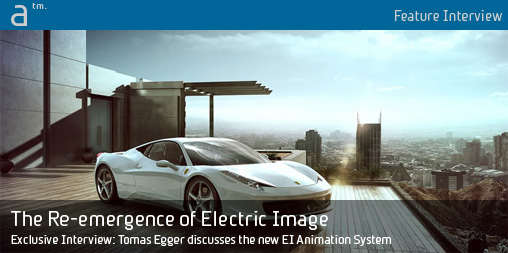Background on Electric Image
For those of you in the 3D software space who are too young to remember the original TRON movie, chances are you may not know much about Electric Image and its storied history. Although this interview is focused on the present Electric Image Animation System software and, more importantly, its future, we wanted to go back in time a bit and recount some valuable history.
Anthony Frausto-Robledo (AFR): Tomas, you are the new owner of Electric Image Animation System, commonly known as EIAS and have been for a few years now. Can you tell me about how that came about? How did a film director and VFX supervisor end up co-owning a legendary piece of software like Electric Image?
Tomas Egger (TE): I bought my first copy of EIAS (Electric Image Animation System) in 1996 (version 2.7) because I was amazed with the EIAS Demo Reel. It contained a lot of work created by John Knoll of ILM (Industrial Light and Magic) using a Mac. I have always used Macs.
I become totally addicted to the idea of an easy-to-use Macintosh 3D application that could handle tons of geometry while generating gorgeous and amazingly fast renderings. I used the software to produce documentary animations and CGI for advertising. I also created several Music Videos using EIAS. Several of these videos won Brazilian MTV awards. EIAS helped me to become a CGI artist, a VFX supervisor, and finally a film director.

01 - A sample of the stunning rendering capabilities of Electric Image Animation System (EIAS 9). (image courtesy of EIAS 3D. All rights reserved. Image created by Ash Bird. Title image above also courtesy of EIAS 3D, Image created by Ash Bird.)
AFR: So EIAS was, in essence, a gateway to your award-winning career in film and VFX.
TE: Yes, very much.
AFR: Can you tell me more about those early years working in VFX and Electric Image?
TE: When I started to create my music videos and more complex CGI TV ads I was invited to work closely with the EIAS beta testing team and the developers, including “The Igors”. I have met most of the best VFX artists in the field there and I learned a lot. I gained an understanding of how to create better CGI effects and which software features needed to be expanded on.
AFR: Looking back at the history of Electric Image, what do you feel was the most important moment or moments in its famous past? Is there a particular film project or technology that comes to mind?
TE: A few key moments for me include the Star Wars Special Edition trilogy, which used a lot of EIAS with full 3D space ships and camera maps…camera maps or Cmaps were added to EIAS at the request of ILM and it was the first Camera Map system available in commercial 3D software. Other key moments included Space Rangers (John Knoll), Terminator 2 – Nuclear Destruction, and Mission Impossible (ILM).
AFR: How involved are the Igors with the future of Electric Image? What role do they play in the new Electric Image?
TE: They have been the key developers of EIAS in recent years and were helping me to achieve my goals on my latest projects. We work well together — I‘m more of a dreamer and they are more logical. I really admire their work.
Next page: Electric Image Through the Years








Reader Comments
Comments for this story are closed